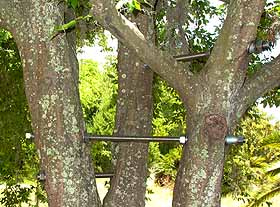Brace For It
January 16, 2024 4:05 pmA recent client of ours had several trees in need of pruning on his property. One in particular, a Chinese Pistache, had three primary leaders that all originated next to each other, about 6-feet up the trunk. The way these leaders had developed created three weak crotches at their origination. As the leaders develop and get longer and heavier it is difficult for the tree to maintain structural integrity at that juncture. Each leader has holding wood on the trunk – which means each of the three leaders has only one third share of the structural strength of the trunk at the junction where they separate. There’s a high potential for failure, with the trunk likely to split.
It was apparent that several years ago, the trunk of this Chinese Pistache had slightly split at the crotch, or junction, of the three leaders. In reaction to the split, the tree naturally protected itself by forming a cambion roll over the edge of the split to prevent the exposed wood from decaying. The client recognized that this had occurred, but never thought anything of it.
Over the years, the leaders had grown and become heavier, finally splitting the trunk. The split was over a foot and a half in length, down below the crotch of the three leaders. The client recognized that this was a much larger problem now, and called Lone Oak to remedy the situation. The remedy, in this case required bracing.
Bracing is a procedure to either prevent branch or leader failure, or to mitigate partial failures. A partial failure could happen wherever leaders or major branches are splitting at a crotch. To brace a leader, a long rod is used to bolt the failing leaders, or branches, in place to prevent them from splitting further. Trees that develop narrow crotches between major branches or leaders are at most risk.
In the case of this client, the leaders required bolting, but the trunk was splitting as well. A continuous hole was drilled through the failing leader branch and through another supportive leader branch. Then a threaded bolt was cut to length to span between the outside of the failing branch and the outside of the supportive branch. Washers and nuts were added at each end to hold the failing branch in place (illustrated in the photo below). Eventually the tree will grow over and around the openings and hardware. We also used this technique to close the crack in the trunk by drilling a hole through the diameter of the trunk, pulling it back together through the tightening of the bolts. This tree should now be able to live on without major failure.


Categorised in: Uncategorized
This post was written by admin
Comments are closed here.